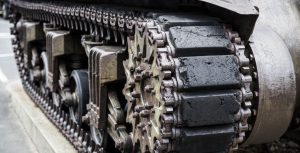The Lithuana Tribune: 21. august 1968 in CSSR
On 21 August, we mark the beginning of the occupation of Czechoslovakia, which the Communist Party also calls the entry of Allied troops. Troops entered Czechoslovakia on 20 August 1968. The operation was codenamed the Danube. It was a military invasion by the armies of the five socialist countries of the Warsaw Pact – the Soviet Union, Hungary, Poland, Bulgaria and the German Democratic Republic (GDR), led by the Soviet Union – which meant the subsequent 23-year military occupation of Czechoslovak territory, halting and reversing the ongoing democratisation reforms.
Before the entry of troops, there was the Prague Spring. This was the term used to describe the processes known in the Soviet Union as perestroika. Censorship was lifted. Those convicted in the 50s were rehabilitated. Public opinion studies began, and social sciences developed. People were allowed to travel to capitalist countries. This and the Prague Spring did not please the leadership of the Soviet Union, Poland, and the GDR.
On Wednesday, 21 August 1968, foreign troops occupied most of the strategic locations throughout Czechoslovakia (they entered Czechoslovakia before midnight on Tuesday, 20 August, and the first airborne unit landed at 2 a.m. at Ruzyń airport in Prague). The operation involved about half a million soldiers and about 6,000 tanks. Soviet General I.G. Pavlovski led the operation.
The intervention was the machinations of the conservative part of Czechoslovakia’s Communist Party (invitation of Biljak, establishing Workers and Peasants Government, etc.) and the general situation in Europe, which was divided by the Iron Curtain into the Western and Eastern Blocs. While Soviet tanks crushed protests in the GDR (17 June 1953) and Hungary (1956), where they killed hundreds to thousands of people within days, and hundreds more were subsequently sentenced to death by emergency courts, political normalisation began in Czechoslovakia, following the invasion, triggered by Brezhnev’s doctrine of limited sovereignty. The Western powers also respected the previous arrangements with the USSR because they were busy with their problems (the Suez crisis, Vietnam war, 1968 civil protests in Paris, for example) and preparing strategic arms limitation negotiations with the USSR, so their reactions remained merely declarative.
For the operation, designated “Operation Danube”, the Warsaw Pact forces allocated 27 divisions (12 armoured, 13 motorized infantry, 2 airborne) and 1 air force with a combined strength of 200 to 750,000 soldiers, 800 aircraft, 2 to 6,300 tanks. 2,000 guns and rocket launchers, which altogether exceeded the strength of the Czechoslovak People’s Army. The forces of the Eastern Military District of Czechoslovakia were not at full strength at the time of the invasion. According to some estimates, there were six interventionist units per Czechoslovak division.
About 28,000 Polish and about 30,000 Hungarian soldiers took part in the operation to crash the Prague Spring. The GDR army was represented by only one command and reconnaissance unit. Bulgaria deployed 10,000 soldiers.
During the invasion, 108 Czechs and Slovaks died in skirmishes with the invaders or in accidents. 29 were killed in Slovakia, one Slovak (19-year-old Milan Lamper) was also killed in clashes around a radio station in Prague on the first day of the invasion, and a Slovak (Anna Trehova) near Brno. In 2017 Czech historians renewed the number of direct victims of the invasion to 137 at the end of 1968, and in 2019 created an interactive map (148 victims in the first year).

The invasion caused a large wave of emigration abroad. Some 450,000 people emigrated in the following period.
During resistance demonstrations and several attacks on the invasion troops, 12 Soviet soldiers (one officer, four non-commissioned officers and seven soldiers) were killed; another 87 were hospitalized, 25 of them due to armed clashes with the population.
In addition, 86 servicemen were killed in air and road accidents. Overall, however, there were no significant armed clashes, thanks in part to a declared commitment to keep the peace.
Especially the fighters of the first invasion wave, who crossed the border during the night of 20 to 21 August, were taken aback by the behaviour of civilians; many gradually began to realise that they were deceived and that entry into the Czechoslovak territory was illegal and wrong. By September 20, 1968, five Soviet soldiers had committed suicide on Czech and Slovak territory. In the days that followed, the Soviet command replaced most first-wave troops with fresh units. They no longer encountered resistance to the extent that their predecessors had, largely due to the gradual dulling and eventual pacification of public opinion in the country.
The Communist leadership rejected the possibility of armed resistance and, in the words of President Ludvik Svoboda, urged the population to keep the peace; despite this, in several places, people spontaneously stood in the way of tanks. As a form of non-violent resistance, Warsaw Pact soldiers were met with rebukes as occupiers. At first, some civilians tried to persuade the soldiers, but to no avail. People protested in the streets with banners and pictures of the General Secretary of the Communist Party of the Czech Republic Dubček and President Ludvik Sloboda. Signs and graffiti on walls and pavements denounced the occupiers, the Soviet leadership and local collaborators.
In an attempt to stop or at least slow down the troops’ advance, people tore down or changed the directional signs and added new ones indicating the opposite direction to Moscow. Soldiers of the occupation troops responded to such actions by shooting at the crowd of protesters in several places, resulting in human casualties. Protests against the invasion lasted only about a week. Apart from intimidating soldiers and tanks, the signing of the Moscow Protocol on 26 August 1968 was seen by many as the ultimate defeat and betrayal of the Communist leadership. However, the protests meant that Dubček, who had been arrested on the night of 20 August 1968 and was to be replaced immediately, could remain in his position.
Politicians and residents in the Czech and Slovak Republics commemorate the sad anniversary of crushing the Prague Spring every year. This year, the intervention is even more compared to the Russian Federation’s war against Ukraine.
Prameň: https://lithuaniatribune.com/





